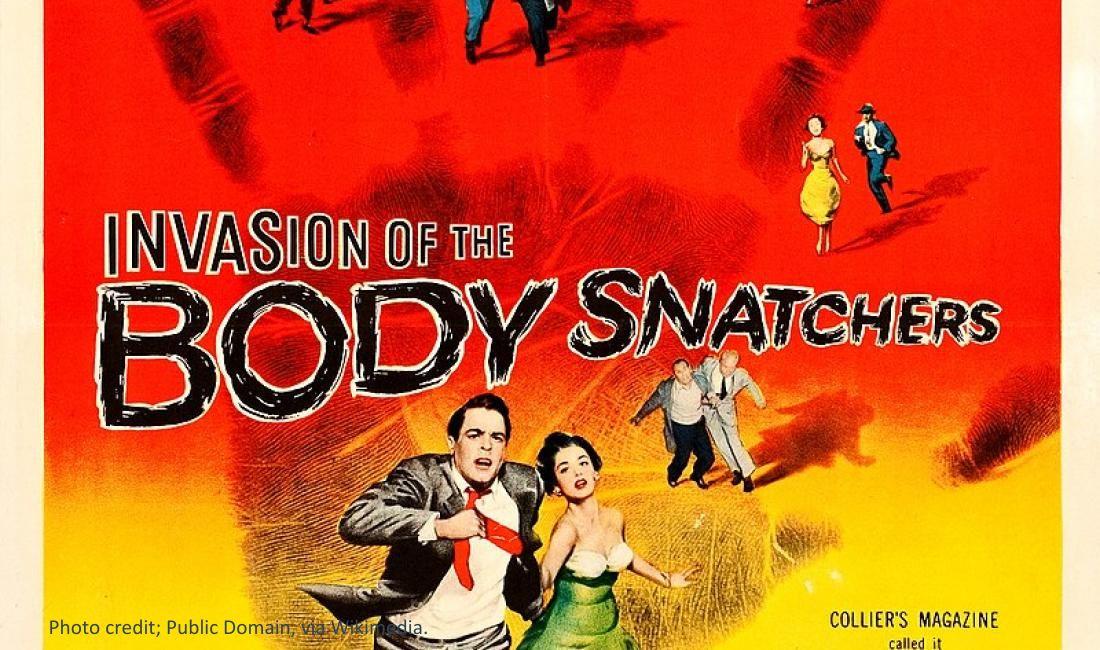Local government vs the planetary threat
Photo credit; Public Domain, via Wikimedia.
Maybe I’ve been watching too many old movies.
Or maybe the body snatchers are back.
We’ve seen them twice before in my home state of California. Both invasions—of pod aliens, who secretly arrive from outer space to make our bodies their own—may have been interstellar, but they showed up first as attacks on local communities, forcing local governments to handle response.
Neither our institutions nor our officials were up to the challenges back then. Today, with the body snatchers back, and not just in the Golden State, local governments seem less prepared than ever to fight back and defend themselves against these insidious enemies and the existential threat they pose to human survival.
The first invasion came in 1956, in Santa Mira, California—though you won’t find the city on any map—and no one was ready. Yes, several townspeople noticed that their relatives and friends, who looked and sounded the same, no longer seemed to be quite themselves. Only a local health official, Dr. Miles J. Bennell, investigated. But by the time he figured out what was up, there were no humans left in town to believe him. The pod people had taken over their bodies. He fled.
Then, in 1978, the body snatchers arrived in San Francisco. Only a San Francisco County health inspector, Matt Bennell (no obvious relation to the Santa Mira doctor), recognized the problem. But he and the local health bureaucracy couldn’t keep up with the pod people. In just a few days, the aliens, demonstrating an otherworldly commitment to using the Bay Area’s famously disjointed transit system, replaced virtually all the humans across the region.
Now, at this point I must confess that not everyone believes these body snatchers were real. Many people maintain they were just the villains in two different classic horror films, both named Invasion of the Body Snatchers.
And perhaps the body snatchers were just cinematic.
Or perhaps that’s what the pod people want us to believe.
Regardless, cultural pundits have seized on possible larger meanings of the body snatcher invasions, and how they reflected the political and cultural fears of their respective eras.
Critics suggested the 1956 Invasion of the Body Snatchers was about how McCarthyism had seized our minds, transforming many Americans into paranoid, red-hating anti-communists. “I’ve been gone for five years. I feel like a stranger in my own country,” says one Santa Mira resident who suspects that their neighbors are no longer the people he once knew.
The 1978 Invasion of the Body Snatchers, set in gritty San Francisco, was said to be about the alienation created by that decade’s violence, urban chaos, pollution, and the loss of social trust. Adding to the anxiety of the era, the film appeared in theaters just three weeks after the assassinations of Mayor George Moscone and Supervisor Harvey Milk.
“It’s like there’s some kind of hallucinatory flu going around,” says a San Francisco psychiatrist, who looks a lot like Leonard Nimoy. The health inspector Bennell, the spitting image of Donald Sutherland, says, “I know I feel like I’ve been poisoned today.”
While watching these two films during the scarily hot and fear-filled summer of 2024, I found them timely, relevant—and real.
Today, our neighbors and friends don’t seem quite themselves. It’s as if they have been taken over by loneliness. It’s as if their once-open minds have been seized by conspiracies or political extremism.
Is the unusual heat of this summer the reason why so many people don’t move like they usually do? Or have the pod people taken over their bodies? Are the people we encounter online real humans, or digital replicants, created by AI?
The pod people don’t want us to ask these questions. “Don’t be trapped by old concepts, Matthew,” says one pod person to the health inspector in the 1978 film. “You’re evolving into a new life form.”
But the power of body snatchers stories is more than metaphorical. These movies are also straightforward stories of local officials just trying to do their jobs against overwhelming odds. And that’s the really scary thing: our local governments are nowhere near strong enough to protect us from planetary threats—be they climate change, disease, or even pod people from outer space.
The trend lines on local power aren’t good. The second time the body snatchers showed up, in 1978, was also the year that voters passed Proposition 13, taking taxing power from California’s local governments. Today, those governments, after flailing through the pandemic, are even weaker. Local health departments have been gutted, and our municipalities are unable to solve, or even much reduce, persistent homelessness.
In the final scene of the 1978 Invasion of the Body Snatchers, the health inspector Bennell walks toward the San Francisco City Hall, that domed symbol of self-government. The audience thinks he might be going to help the few humans who have hidden themselves in the city. But it turns out that the health inspector’s own body has already been snatched, and the Bay Area’s remaining humans must survive on their own.




